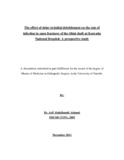| dc.contributor.author | Asif, Abdulhamid A | |
| dc.date.accessioned | 2012-11-28T12:26:39Z | |
| dc.date.available | 2012-11-28T12:26:39Z | |
| dc.date.issued | 2011 | |
| dc.identifier.uri | http://erepository.uonbi.ac.ke:8080/xmlui/handle/123456789/6913 | |
| dc.description.abstract | Background:
The tibia is the most commonly fractured bone in the body. A large number of tibial fractures are open. Among many other factors affecting the eventual outcome of fracture management is the time of debridement from the initial time of injury. The rate of infection is one of the important clinical parameters in the outcome.
Objectives:
The aim of this study was to evaluate the effect of delay in debridement on the rate of infection in open fractures of the tibial shaft.
Materials and Methods:
The study was a prospective study conducted at KNH from the months of July 2011 to October 2011. Forty eight patients who met the selection criteria were enrolled in the study and followed for six days from the time of debridement. Outcome variables were the presence of clinical and microbiological evidence of infection. These were correlated to the time from injury to debridement. The fracture classification as described by Gustilo was used to group the outcomes.
Data collection was done using a structured questionnaire and analysis done using SPSS version 17.0.
Results:
In this study, patients arrived at the hospital at a mean time of 6 hours from the time of injury.
It took a mean time of 15 hours in the hospital before debridement to be done. The total mean time from injury to debridement was 21 hours. It was found that when debridement was performed within 6 hours of injury no infection was encountered. This finding was statistically significant (p=0.038). The severity of the fracture as described by the Gustilo grading affected the rate of infection encountered.
Conclusions:
Open fractures of the tibial shaft should be debrided as early as possible, preferably within 6 hours of the injury since it was found that there is a statistically significant chance (p=O.038) of avoiding infection if a compound fracture of the tibia is debrided within 6 hours of injury. Fractures with a higher Gustilo grade should be given more priority in order to minimize infection as far as possible. In this study, it was found that patients suffered a long delay in arriving at hospital after injury, as well as a long delay in hospital awaiting debridement of their open fractures. Ways of reducing these delays should be explored. | en_US |
| dc.language.iso | en_US | en_US |
| dc.publisher | University of Nairobi, Kenya | en_US |
| dc.title | The effect of delay in initial debridement on the rate of infection in open fractures of the tibial shaft at Kenyatta National Hospital-a prospective study | en_US |
| dc.title.alternative | Thesis (M.Med.) | en_US |
| dc.type | Thesis | en_US |

